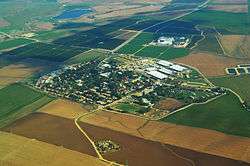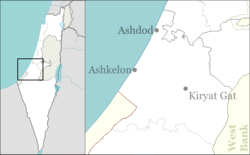Gat, Israel
Gat (Hebrew: גַּת) is a kibbutz in southern Israel. Located near Kiryat Gat, it falls under the jurisdiction of Yoav Regional Council. In 2018 it had a population of 827.[1]
Gat גַּת | |
|---|---|
 | |
 Gat  Gat | |
| Coordinates: 31°37′37.91″N 34°47′38.76″E | |
| Country | |
| District | Southern |
| Council | Yoav |
| Affiliation | Kibbutz Movement |
| Founded | 1934 |
| Founded by | Jewish immigrants from Poland, Yugoslavia and Austria |
| Population (2018)[1] | 827 |
| Website | www |
History
Kibbutz Gat was founded in 1934 by Jewish immigrants from Poland, Yugoslavia and Austria. In 1949, after the inhabitants of the nearby Palestinian village of Iraq al-Manshiyya had been expelled, some of their lands were transferred to Kibbutz Gat.[2] Primor, one of Israel's largest juice manufacturers, is operated by the kibbutz. Citramed, another company located in Kibbutz Gat, has developed a method to squeeze out the antibacterial properties in the rind of citrus fruit for use as a natural preservative in health products and the food industry.[3]
The name is derived from the Philistine town Gath, which at the time the kibbutz was founded was identified with the nearby site of Tel Erani. The town of Kiryat Gat (lit. Gath City) was named for the same reason. However, most scholars now consider Tell es-Safi, thirteen kilometres to the northeast, a more likely candidate.[4]
 Gat 1945
Gat 1945 Building the kibbutz
Building the kibbutz
Notable residents
References
- "Population in the Localities 2018" (XLS). Israel Central Bureau of Statistics. 25 August 2019. Retrieved 26 August 2019.
- Khalidi, Walid (1992). All That Remains. Washington D.C.: Institute for Palestine Studies. ISBN 0-88728-224-5. p.108
- Citramed's citrus extract Ministry of Foreign Affairs
- Horton Harris (2011). "The location of Ziklag: a review of the candidate sites, based on Biblical, topographical and archaeological evidence". Palestine Exploration Quarterly. 143 (2): 119–133. doi:10.1179/003103211x12971861556954.